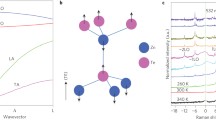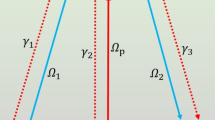Abstract
An attempt is made to extend the spectacular variant of optical informatics efficient at liquid helium temperature—holography based on zero-phonon lines (ZPLs) and spectral hole burning, including time-and-space-domain holography—to higher temperatures, up to room temperature. At room temperature, both optical and Mössbauer narrow ZPLs exist; however, they do not have the inhomogeneous broadening that transforms a ZPL into a broad band, which is necessary for informatics based on light pulses. The idea of producing a band with an appropriate width from narrow ZPLs by using the Doppler effect is advanced. A variant of experimental realization of this idea by means of a scheme with a rotating disk covered by a layer of a material sensitive to spectral hole burning is considered. Numerical estimates were performed for narrow optical ZPLs and for the yet experimentally unconfirmed Mössbauer ZPL in the visible spectral range (dark blue nuclear light) that corresponds to a transition between the two low-lying levels of the 229Th isomer. For the narrowest optical ZPLs known at present, with a width of about 100 Hz, the estimates give favorable results, in particular, for prospects of realizing a photoelectrically accumulated stimulated photon echo.
Similar content being viewed by others
References
K. K. Rebane, J. Lumin. 100, 219 (2003).
K. K. Rebane and A. K. Rebane, in Molecular Electronics, Properties, Dynamics and Applications, Ed. by G. Mahler, V. May, and M. Schreiber (Marcel Dekker, New York, 1996), p. 257; C. De Caro, S. Bernet, A. Renn, and U. P. Wild, in Molecular Electronics, Properties, Dynamics and Applications, Ed. by G. Mahler, V. May, and M. Schreiber (Marcel Dekker, New York, 1996), p. 303.
K. K. Rebane, Chem. Phys. 189, 139 (1994).
Persistent Spectral Hole Burning: Science and Applications, Ed. by W. E. Moerner (Springer, Berlin, 1988); T. Basche, W. E. Moerner, M. Orrit, and U. P. Wild, Single-Molecule Optical Detection (Weinheim, New York, 1997).
K. K. Rebane, in Current Trends in Optics, Ed. by J. C. Dainty (Academic, London, 1994), p. 177; A. Rebane, in Trends in Optics, Research, Developments and Applications, Ed. by A. Consortini (Academic, New York, 1996), pp. 165–188; A. Rebane, Thesis (Lab. of Phys. Chemistry, ETH-Zentrum, Zürich, 1995), CH-8092; F. Güttler, Dissertation No. 10707 (ETH, Zürich, 1994).
K. Rebane, Mol. Cryst. Liq. Cryst. 236, 13 (1993).
R. Jaaniso and H. Bill, J. Lumin. 64, 173 (1995).
K. Rebane, in Proceedings of 8th HBRS-2003 (Bozeman, Montana), J. Lumin., Special Issue (2004) (in press).
C. W. Reich and R. G. Helmer, Phys. Rev. Lett. 64, 271 (1990); R. G. Helmer and C. W. Reich, Phys. Rev. C 49, 1845 (1994).
E. V. Tkalya, A. N. Zherikin, and V. I. Zhudov, Phys. Rev. C 61, 064308 (2000); E. V. Tkalya, Usp. Fiz. Nauk 173, 323 (2003) [Phys. Usp. 46, 315 (2003)].
A. V. Andreev, P. A. Volkov, B. M. Gordienko, et al., Kvantovaya Élektron. (Moscow) 26, 55 (1999).
S. H. Simon, A. L. Moustanas, M. Stychev, and H. Safar, Phys. Today 54 (Sept.), 38 (2001).
Physical Encyclopedia, Ed. by A. M. Prokhorov (Sovetskaya Éntsiklopedia, Moscow, 1990), Vol. 2, p. 15.
A. K. Rebane, Pis’ma Zh. Éksp. Teor. Fiz. 38, 320 (1983) [JETP Lett. 38, 383 (1983)]; A. K. Rebane, R. K. Kaarli, and P. M. Saari, Opt. Spektrosk. 55, 405 (1983) [Opt. Spectrosc. 55, 238 (1983)].
P. Saari, R. Kaarli, and A. Rebane, J. Opt. Soc. Am. 83, 527 (1986).
Y. Sun, G. M. Wang, R. L. Cone, et al., Phys. Rev. B 62, 15443 (2000).
K. K. Rebane and V. V. Palm, Opt. Spektrosk. 57, 381 (1984) [Opt. Spectrosc. 57, 229 (1984)].
V. V. Khizhnyakov and I. K. Rebane, Zh. Éksp. Teor. Fiz. 74, 885 (1978) [Sov. Phys. JETP 47, 463 (1978)]; I. K. Rebane, A. L. Tuul, and V. V. Khizhnyakov, Zh. Éksp. Teor. Fiz. 77, 1302 (1979) [Sov. Phys. JETP 50, 655 (1979)].
Author information
Authors and Affiliations
Additional information
__________
Translated from Optika i Spektroskopiya, Vol. 98, No. 5, 2005, pp. 845–849.
Original Russian Text Copyright © 2005 by Rebane.
Rights and permissions
About this article
Cite this article
Rebane, K.K. Controllable broadening of zero-phonon lines by means of the Doppler effect and prospects of using spectral hole burning in optical informatics. Opt. Spectrosc. 98, 776–779 (2005). https://doi.org/10.1134/1.1929065
Received:
Issue Date:
DOI: https://doi.org/10.1134/1.1929065




